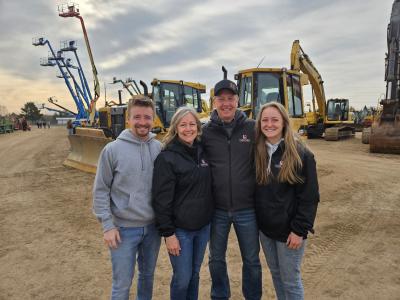Somewhere in current construction activities, fatal accidents lie in wait.
The construction industry reported 1,225 fatal occupational injuries during 2001, according to statistics recently released by the U. S. Department of Labor’s Occupational Safety and Health Administration (OSHA) in Washington, D.C. This total, which does not include 58 contractor personnel lost in the Sept. 11 attack, was a six percent increase over 2000. It was, in fact, a record — the highest number of deaths in the industry since OSHA began compiling a grim census of occupational fatalities in 1992.
Consider this fact, too. Deaths in construction represented approximately 23 percent of the 5,270 fatalities in private industry last year.
“We are disappointed at the rise in the numbers,” H. Berrien Zettler, deputy director of OSHA’s Construction Directorate in Washington, told Construction Equipment Guide (CEG). “We are very unhappy with the increase. We also think that the fatality rate [13.3 deaths per 100,000 construction personnel working in the private sector] is too high, rising from 12.9 in 2000. We’ve been concerned about the rate in construction for the past 10 years.”
More than 400 construction workers fell to their deaths in 2001. This was a 13 percent increase over 2000, and accounted for over half of the record 808 deaths from falls on the job throughout industry during the year.
An average of 16 workers were fatally injured each day during 2001. In construction, the most fatalities were among laborers, who suffered 349 fatal accidents during the year. The average fatality rate for these laborers was 33.5, the highest rate of any group in the United States, where the average for all occupations is only 4.3 (the second-highest rate is for farm occupations at 27.9 percent, and the third-highest is for truck drivers at 25.3 percent.)
There were 666 job deaths in the construction trades. This was 11 percent of total fatalities in all industries.
One reason for the increased toll in construction, of course, is that the construction workforce has, at least until recently, continued to grow, reaching well over nine million. But even one more death is one too many.
What to Do?
How can the construction industry cut its workplace deaths? Is there something contractors are failing to do? Where are the answers? Even one life saved is worth extraordinary efforts, but nothing seems to come easily in this vital area.
“We’ve set up a task force that is looking at new ways in which OSHA might target construction-enforcement inspections,” Zettler said. “We want to get to the people who seem to be paying insufficient attention to safety on the work site. We’re going to try to figure out ways of reaching them, but that’s particularly difficult in construction because, as you know, work sites keep changing. We might identify a contractor who has a high rate of injuries, or illnesses, or fatalities, but, when we go to the person’s job, that job only lasts for a short time.
“The other peculiar thing about construction is that a lot depends on who the general contractor is. A specialty-trained contractor can be safe on one site and unsafe on another. It’s a very difficult issue to get your hands on. We are very seriously looking at different programs that we might be able to implement with the industry to try to get those fatalities down. We’re not at all happy with the increases.”
Zettler said OSHA is focusing on such steps as a new inspection-targeting program, partnerships with industry, and agreements in principle “that we will all try to do that which contributes most to safety and health.”
The constant progress on new or improved standards also makes the whole industry safer and more aware, and is an incentive attracting people to construction careers (see sidebar).
Recognizing that a well-trained person will tend to work safer, OSHA also is now certifying trainers to teach safe procedures to the industry in 10-hour or 30-hour courses.
Another step: After analyzing data from the census of work fatalities, OSHA plans to provide grants for further studying the reasons behind construction accidents. Some companies actually have written mission statements in which they make employee safety their highest priority, even above profits. Should more contractors do this?
“We would, of course, like that,” Zettler said. “Our basic mission is to try, in every way that we can, to get employers to pay more attention to safety and health in the workplace. Nobody’s perfect in that regard, so we always are pushing that priority both at the headquarters and regional levels.”
Is there anything that contractors are neglecting, or overlooking, in their safety programs?
“We haven’t fully analyzed the statistics, but I suspect the data will be as it always has been,” said Zettler. “About one-third of the people who die will still die from falls. That’s a very significant topic. Nobody ever thinks they’re going to fall, but they do. The people who fall, of course, don’t have fall-protection. That’s certainly a major concern with safety-minded people in the industry. We’ve been preaching fall protection for years, and even issued a new standard on it in 1995.”
Do contractors and employees simply forget the importance of safety?
“That’s a matter of opinion,” Zettler responded. “I will study the data from the latest national overview and draw the conclusions which the data suggests.”
Reliable Source
OSHA’s report, called “The Census of Fatal Occupational Injuries,” uses both state and federal data sources, including death certificates and workers’ compensation records.
This is the 10th year that the fatality census has been conducted in all 50 states and the District of Columbia.
For industry as a whole, the census reported that highway incidents increased by approximately 3 percent from 2000 and continued to be the leading cause of the on-the-job fatalities.
Fatal work injuries resulting from workers being struck by vehicles or mobile equipment also increased slightly in 2001. But non-highway fatal incidents, which include tractor and forklift overturns, were at their lowest levels since the census began in 1992.
Work-related homicides (excluding Sept. 11) stood at 639 — their lowest level since the census began (The record high was 1,080 in 1994.) Homicides among technical, sales and administrative support personnel decreased 14 percent to 203, but increased sharply among workers in service occupations, including police, food preparation workers, barbers and hairdressers.
Construction’s fatality rate of 13.3 was less than mining (30) and agriculture, forestry and fishing (22.8).
Although increasing in construction, total fatalities decreased 10 percent in manufacturing, and also dropped in transportation and trade, but increased 10 percent in government (excluding Sept. 11), with smaller total increases in mining, agriculture, finance, insurance and real estate.
Today's top stories















